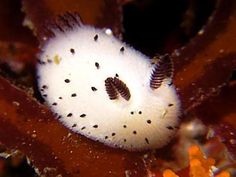JORUNNA PARVA
Jorunna parva is a strange animal because it’s a type os sea slug and it’s looks like a rabbit, but it’s not a rabbit.
It’s a small animal, the most are less than 2.5 centimeters long and may be found in the Indo-Pacific Ocean of Africa South to the central Pacific, (Japan, Philippines, Seychelles, Papua New Guinea…). Although the most popular features of these animal show white animal with black spots, these sea slugs are usually yellow or orange. The two antennas on top of its head,are sensory organs. Called rhinophores, they detect chemicals substances in the water that helps sea bunnies find food and mates. The rhinophores are covered in little flaps that boost their detection capabilities, allowing Jorunna parva to sense its environment very efficiently. This animal eats sea sponges, this sea esponges are toxic, when they feed on them, absorb these toxins and used them to defend themselves against their enemies.
The sea bunny, like most sea slugs, is a hermaphrodite. They have both male and female reproductive organs, and when they mate, both partners exchange spermatozoide.
The Jorunna parva can live between four month and one year.
www.nauticalnewstoday.com
www.nationalgeographic.com
BY: Fatima, Paula, Sergi








